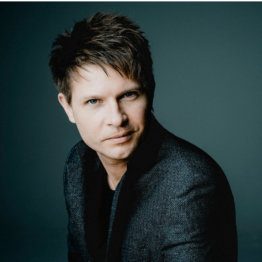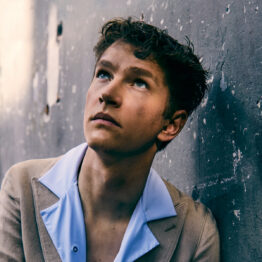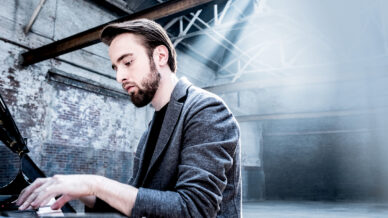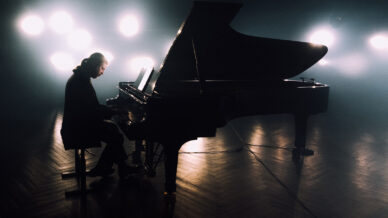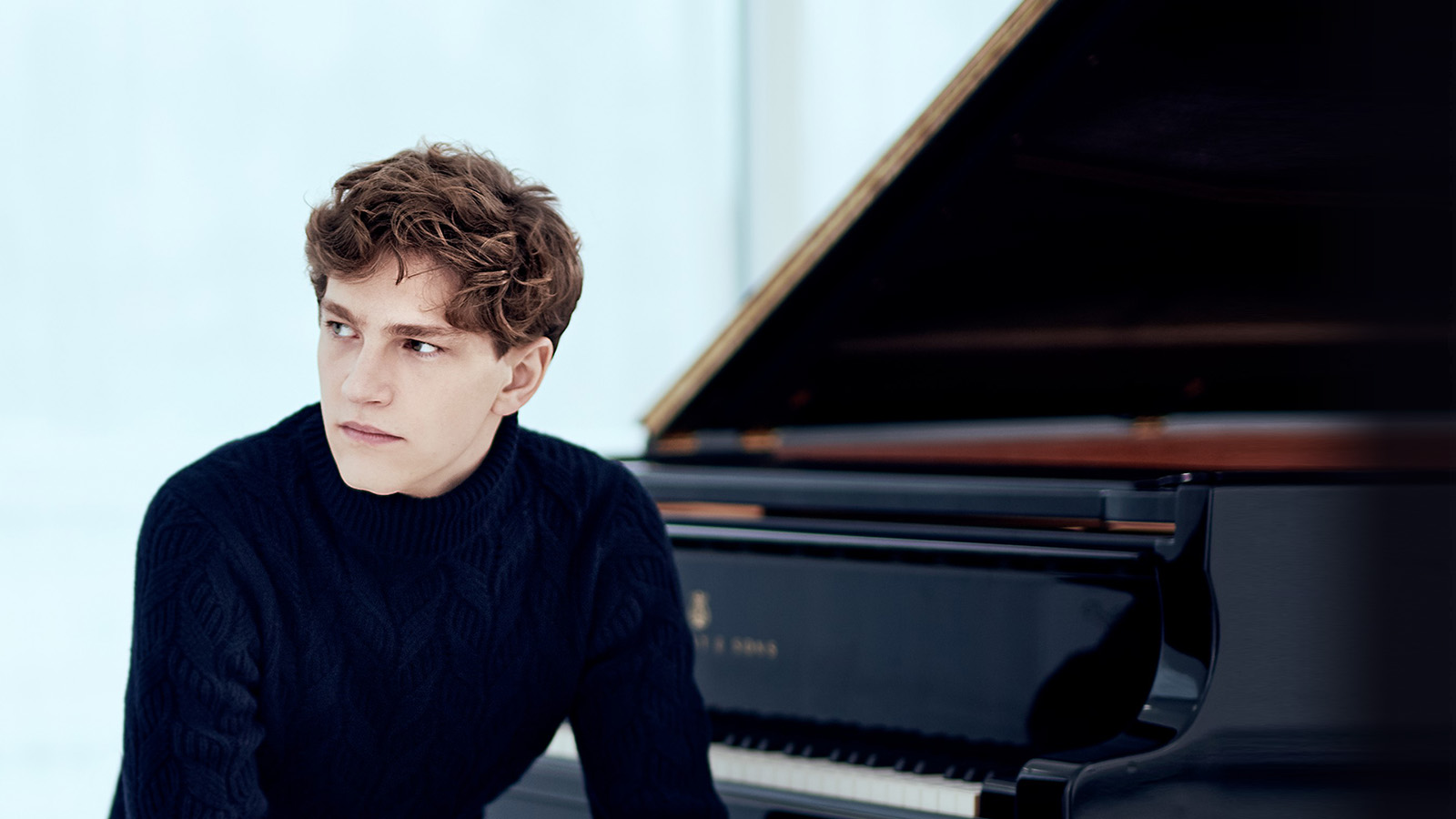

Chopin and Shostakovich
March 7 – 10, 2024
KRZYSZTOF URBAŃSKI conducts
JAN LISIECKI piano
CHOPIN Concerto No. 1 for Piano and Orchestra
SHOSTAKOVICH Symphony No. 10
After Stalin died, Shostakovich, having suffered under the repressive Soviet regime, unleashed his fury against the dictator in his Tenth Symphony — a titanic struggle pounded out in a code of savage pitches equivalent to his initials D-S-C-H (in German musical notation) — crushing the tyrant in the triumphant finale. Raising the curtain is Chopin’s rhapsodic Concerto No. 1, full of poetry and passion.
PERFORMANCE PRELUDES
Join us for a special pre-concert talk with Assistant Conductor Maurice Cohn! The talks will take place from Horchow Hall starting at 6:30pm on Thursday and Friday and 2:00pm on Sunday.

Program Notes
by René Spencer Saller
Translating music into words is tricky. We struggle to describe the sounds we hear, but all we have are adjectives, metaphors and cliché. If Walter Pater was right when he argued that “all art constantly aspires towards the condition of music,” how do we talk about music? Listening, in its purest, most deeply rewarding state, bypasses the language region of the brain to trigger something deeper, more instinctive and primal. Call it the id, the unconscious, the heart, the soul, the self – more metaphors. The music we love will always elude our attempts to describe it. To persuade yourself of this argument, simply listen to some Chopin.
Chopin was born Fryderyk Franciszek Chopin in Zelazowa Wola, Poland, to a French father and a Polish mother. A keyboard prodigy, he made his concert debut at age eight. At 20 he performed a pair of farewell concerts in Warsaw, then took off for Vienna. In 1831 he moved to Paris, where he died 18 years later, at 39, after a long battle with tuberculosis. According to legend (likely embellished), he was buried, by his own request, with a silver urn filled with Polish dirt, which he’d kept as a keepsake when he left Warsaw.
Everything Chopin wrote features the piano, either as a solo instrument or in combination with other instruments, and most of his works are short and deceptively simple. Although his style often seems effortlessly lyrical, almost improvisational, he sweated over every measure. Whether he was composing nocturnes, mazurkas, sonatas, impromptus or ballades (a genre he invented), Chopin sounded like no one else. In an age of florid virtuosos, dripping with Lisztian excess, he mastered a fleeting interiority. Sometimes his music seems to blur the boundaries between thought and action, as if it’s willing itself into existence before our very ears.
For a talent so unique, Chopin had conservative tastes. He didn’t think much of Beethoven, much less Berlioz, Liszt and Schumann. The only composers he truly loved were J.S. Bach and Mozart (whose Requiem was sung at Chopin’s funeral, by his request). He also resisted his own inner weirdo. When the E-minor Concerto was in rehearsal, Chopin wrote to a friend, “I feel like a novice, just as I felt before I knew anything of the keyboard. It is far too original, and I shall end by being unable to learn it myself.”
Piano Concerto No. 1 in E minor, Op. 11, is actually the second of the two that Chopin composed, but the first to be published. It was completed in 1830, when he was 20, in time for his farewell concert in Warsaw.
A Closer Listen
The Argentine-born pianist Martha Argerich once likened Chopin’s Piano Concerto No. 1 to “a very beautiful poisoned flower.” Right away, its strangenesses unfurl, less like a blossom opening than an intoxicating but alien perfume seeping into the atmosphere. Chopin’s harmonies are elusive, and the key wanders into unexpected tonal terrain. The opening movement, in the home key of E minor, is the longest of the three, with at least three distinct themes. Modulating from the tonic to the parallel major, the Allegro maestoso juggles blinding piano dazzle with subtle interplay among the winds and strings.
With its muted, silvery violins, the central Romanze, a nocturne in E major, has the kind of chamber-music intimacy that made Chopin such a hit in the aristocratic salons of 19th-century Paris. Chopin described this movement as “not meant to give a powerful effect; it is rather a Romance, calm and melancholy, giving the impression of someone looking gently toward a spot that calls to mind a thousand happy memories. It is a kind of reverie in the moonlight on a beautiful spring evening.”
From the performer’s perspective, the Rondo—Vivace is a spectacle of terrors: anyone who ever doubted the composer’s pianistic chops should try playing a few measures and doubt no more. Chopin incorporated a syncopated, double-time national dance, the Krakowiak, as a nod to his native Poland, which was then trembling on the precipice of revolution. Three years after the premiere, the 14-year-old Clara Wieck (the future Clara Schumann) performed this finale to great acclaim.
In spring 1945, as the end of World War II approached, Shostakovich announced to the press that he was working on “a symphony of victory with a song of praise.” He suggested that this would be a choral work representing “the awakening of the masses,” possibly even a tribute to Lenin, in the spirit of his wildly popular Symphony No. 7 (“Leningrad”). Shostakovich’s Symphony No. 9 was supposed to be momentous – if not the Soviet counterpart to Beethoven’s Ninth, at least something that was recognizably triumphant. Instead, Shostakovich presented a surprisingly compact work, shorter than some of the movements in his two preceding symphonies. Its mood was humorous, playful, not even remotely heroic. It was purely abstract and Neoclassical, almost Haydenesque at times.
Given Shostakovich’s often tense relationship with Stalin and his henchmen, it’s hard to say whether the composer assumed that this studiously apolitical work would provoke or appease them. At first, the reception was merely disappointing. Soon after its premiere, it simply stopped being performed. Still, the composer seemed to have escaped any real punishment; in fact, he received an Order of Lenin, his third Stalin Prize, and a vacation home. By early 1946, however, Stalin’s right-hand man, Andrei Zhdanov, was waging an all-out war against “bourgeois degeneracy,” which culminated in the Zhdanov Doctrine: “The only conflict that is possible in Soviet culture is the conflict between good and best.”
By October 1946, various speakers at the Composer’s Plenum condemned Shostakovich’s Ninth for its “ideological weakness,” among other crimes. No doubt fearful of losing his career, possibly even his life, the composer wrote a groveling letter to Stalin. This would not be the last time that Shostakovich felt compelled to abase himself. In the late 1940s, he apologized at least twice to Zhdanov and an assemblage of his fellow composers, admitting that his work had suffered from “many failures and serious setbacks” and vowing “to work harder and better” and “accept critical instruction.”
The Ninth was banned for the remainder of Stalin’s life and not recorded until 1956, three years after his death. By that point, Shostakovich was, if not cowed, at least (justifiably) paranoid enough not to antagonize the authorities on purpose. Even though the post-Stalin Soviet regime didn’t tyrannize artists as severely or as openly as it once had, Shostakovich had learned the hard way how easily someone could go from prophet to pariah. Assuming you were too big to fail was the surest way to get yourself killed, and Shostakovich intended to survive.
Triumphant Ten
Shostakovich is widely held to have begun Symphony No. 10 in the days after Stalin’s death, but several other accounts, including those of his friends and contemporaries, suggest that he may have begun sketches for it in the late 1940s. He certainly had a strong incentive not to release anything this edgy and ambivalent when Stalin and his culture goons were itching to slap him down again – or worse. But whether Shostakovich intended the second-movement Allegro as a musical caricature of Stalin is open to debate. The main source for this claim is the Russian musicologist Solomon Volkov’s Testimony, purported to be Shostakovich’s memoir, as transcribed from conversations with the ailing composer. The book has since been credibly accused of containing inaccuracies, embellishments and outright fictions. It also appears likely that Shostakovich, who died years before it was published, never saw more than the first eight pages or so. But even if we adopt a healthy skepticism about the source, the story is simply too good to dismiss: “I did depict Stalin in… the 10th,” Shostakovich said (according to Volkov). “I wrote it right after Stalin’s death, and no one has yet guessed what the symphony is about. It’s about Stalin and the Stalin years. The second part, the scherzo, is a musical portrait of Stalin, roughly speaking. Of course, there are many other things in it, but that’s the basis.”
Less controversial is the assertion that Symphony No. 10 celebrates the individual, a tendency that was generally denounced as decadence or bourgeois narcissism under Communism. Just to make it clear that this was Shostakovich’s symphonic “Song of Myself,” the composer based the main motif on pitches equivalent to his initials—transliterated as D–S–C–H in German, and D–E-flat–C–B according to the German convention of musical notation—and this theme clearly triumphs in the finale, symbolically vanquishing, or at least outliving, the ludicrous but deadly and dread-inducing “dictator” theme. One man’s bourgeois narcissism is another man’s swag.
Regardless of when Shostakovich actually began Symphony No. 10, he worked on it primarily in the summer and fall of 1953; Yevgeny Mravinsky led the Leningrad Philharmonic in the world premiere on December 17, 1953, in Leningrad. Reception to the work was mixed, with the Soviet authorities focusing on its perceived pessimism and lack of realism after three days of deliberation. When representatives of the Union of Composers asked Shostakovich if Symphony No. 10 had a program, he was circumspect. “I wanted to convey human feelings and passions,” he explained. “Let them listen and decide for themselves.” As it happened, the apparatchiks’ opinion mattered less than the world’s: premieres in New York and London demonstrated that these “human feelings and passions” were universal. The 10th Symphony became an international hit.
A Closer Listen
Structured in four movements, Symphony No. 10 contains about 52 minutes of music.
The first movement, marked Moderato, is the longest by far, longer than the second and third movements combined. This expansive opening movement starts so quietly that it almost seems like a by-product of silence, or like the sound silence makes when it wills itself out of existence. The music waxes and wanes, a dramatic corollary to the “human feelings and passions” that Shostakovich wanted to convey. “In this,” Shostakovich later explained of the first movement, “there are more slow tempi and lyrical moments than dramatic, heroic and tragic.” After the cellos and basses present the first theme, a brooding six-note motif, punctuated by a sharp silence, Shostakovich magnifies this little idea to deliberately absurd extremes. The second theme is voiced by clarinet; the third by flute – a queasy, dread-inducing waltz figure over pizzicato strings that wouldn’t sound out of place on the soundtrack of an arty horror movie.
My friend Ted Rubright, a timpanist, tells me that the “epic” machine gun–like snare drum part of the second-movement scherzo (the presumed Stalin portrait) is an audition mainstay. A punishing moto perpetuo tempo propels screechy-screamy winds and bellowing brass, as seemingly benign tones turn malignant with a vicious crescendo. Any tender, potentially lyrical moments are brutally extinguished in this deranged death march of an Allegro.
The penultimate movement, a waltz marked Allegretto, is where Shostakovich lets his musical-motif alter-ego have a little fun, even if it’s disorienting, spooky fun. Along with his signature cipher (D, E-flat, C, and B), re-introduced early on by clarinets and flutes, a solo horn sings a complementary motif, one derived from the name of one of Shostakovich’s female pupils, Elmira Nazirova (E, A, E, D, A), his probable lover. He told her in a letter dated September 17, 1953, that “her” horn theme was a transliteration of her name and also based on a song from Mahler’s Das Lied von der Erde. Even if you prefer not to interpret this movement through a biographical lens, the mood is obviously unsettled, if not tumultuous. The mournful beauty of the “Elmira” horn motif gives way to the ghostly asperity of the composer’s signature theme, wispily outlined in piccolos by the end.
The final movement, marked Andante–Allegro, continues the intimate chamber-music vibe of the Allegretto’s final moments, but an almost hysterical whimsy undercuts any semblance of gravitas. In the closing Allegro, the whimsy ramps up until it becomes a reckless, explosive joy, at which point the music takes a sudden turn for the tender. Shostakovich’s personal cipher asserts itself loudly and decisively—proclaimed by the full orchestra, triple forte—only to let the earlier madcap material return one last time, in the form of a bouncy little bassoon hook. At the euphoric climax, the signature theme, now voiced by horns and trumpets, seems as familiar as the face of an old friend. By this point it’s not so much a puzzle to decode as a distinct and distinctive voice to cherish and heed. And just in case any doubt remains about whose voice we’re hearing, I’ll quote my timpanist friend Ted again: “the timpani hammers it home.”
